Triumph of the Eucharist Series
from Bozzetti to Tapestries
Within the Ringling Museum and also on this website (Gallery 1 & 2 link) there is a lot of information
on the Eucharist tapestries' background and especially on the 5 cartoons and 2 tapestries in the museum. Less is published about all the other ones. This paper has tried to fill that gap.
Summary
This paper has brought together photos and information on all twenty tapestries, cartoons, modelli and bozzetti. It discusses Rubens' major contribution and how the tapestry industry worked with cartoon makers, weavers and finishers.
Of interest to the Ringling Museum is that the tapestry of The Four Evangelists hung directly above The Defenders of the Eucharists in the convent church, and that the Abraham & Melchizedek tapestry was not directly woven from the Ringling Museum cartoon.
Introduction
Among his commissions for monumental decorative
programs, Rubens designed four cycles of tapestries. The Eucharist Cycle (1625-27), represents not only
Rubens' largest tapestry commission but also his largest
surviving and most complex program of church decorations.
The tapestries were to hang within the Convent of the Descalzas Reales,
Madrid, commissioned by Rubens' patroness, the lnfanta Isabella,
Governess of the Spanish Netherlands. 3
The tapestries were only displayed on three Eucharistic feasts: The Entombment, the Resurrection and the entire octave (8 days) of Corpus Christi. 8
The precise order and arrangement in which the tapestries were hung has never been exactly reconstructed, because the interior of the church has been extensively modified in 1756. However, the tapestries in all likelihood covered the walls of the church virtually completely. 8
The tapestries have
remained in the convent to this day, but presently hang
merely as individual pieces in a converted dormitory that is not even quite high enough to receive
their colossal dimensions. Click pic. |
|
 |
What does the series comprise of?
All 20 tapestries were commissioned and executed at the same time as part of a single series. They can be split into four groups: 11p44
 |
Group One: The main one comprising
of a series of eleven large narrative tapestries, each conceived
as containing a feigned tapestry hanging within an architectural setting - in other words, a tapestry within a tapestry.
This group, uniform in height but differing in
widths, illustrates a Eucharistic epic in four Old
Testament prefigurations, two allegorical victories of the
Sacrament over paganism and heresy, two groups of
figures announcing and defending the Eucharist, and
finally three magnificent triumphal processions.
Half of the tapestries designs have Doric columns and the other half have Solomonic columns.
The subject matter in the tapestries with the Doric columns have a vanishing point at eye-level, whereas those in the Solomonic columns are seen from below, concluding that the tapestries were designed to hang at two levels with the Solomonic series surmounting the Doric.
The 2 tapestries on the right, based on the Ringling Museum cartoons hung as shown on the right. 8 Read more under te pic. |
|
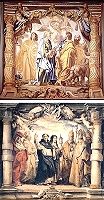 |
 |
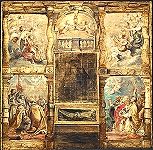
|
|
Group Two: In addition to this narrative series there is a second group
of five narrower tapestries, which together form a
single composition: the Eucharist adored by angels and
earthly rulers of Church and State.
This group was to surround the high
altar of the convent chapel.
The architectural framings are
combined to create the illusion of a two-storied loggia
through which one witnesses the Eucharistic Apotheosis -
the scenes are not on feigned tapestries, as in the preceding
narrative series, but now fill a unified spatial realm in
which Heaven and Earth meet. 3 |
 |
Number Three: King David playing the harp.
Just one tapestry. It has the same columns and is of the same height as the "The Monstrance held by two Cherubs" in the high altar arrangement. It probably hung close by, to the left, near or above the organ.
We see an upper region of heaven in which angels sing, make music and hold the monstrance, while King David plays the harp. 11p64 |
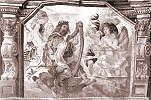 |
|
 |
|
 |
Group Four: Three smaller tapestries, all of which have the same egg-and-dart frame, dealing with allegorical subjects that have alternatively been seen as complementing the Eucharist theme or as "marks or characteristics of the True Church". 4
The three tapestries are: "Succession of Popes", "Charity enlightening the World" and "Histeriography" (on the right).
More info and pics in the table below. |
|
|
|
Procedure: From Bozzetto to Tapestry
Rubens followed the usual
practice of first producing bozzetti (oil sketches) of each
subject, followed by modelli (models), and finally, full-scale
painted "cartoons", which were then woven, at the same size, into the final tapestries.
 |
Bozzetti:
Rubens did the concept sketches in oil on panel board.
The concept design for the high altar was done in one bozzetto. Look here (again) . The size is 12.5 inches square. Five individual tapestries resulted from this concept. The two angels holding a monstrance, at the top, was also turned into a tapestry. More about that in the table below.
The individual sketches for the main series were of the same size as the ones for the high altar. It is thought that Rubens painted several of them together on larger boards, trying out the composition and combinations. 5 At one time in the 18th century, there was a strip of 5 Eucharist bozzetti for sale. At a later date they were cut into individual scenes, probably to increase their value. 1 |
 |
Modelli:
After possible discussion and reviewing of the bozzetti oil sketches with the patron, the next step would be to scale up the design and bring more detail and color into them.
These designs were done in oil on panel and were all ca. 26 inches high with various widths.
The design would now be reversed (mirror-image) in order to have it back to the original design in the final tapestry. However, this is not so in the High Altar designs.
More about that under "Tapestries" below.
Infrared reflectography on some modelli has revealed that Rubens would do a high quality drawing in black chalk on a white ground, which was then closely followed during the next painting stage. 7
It is generally agreed that Rubens executed these modelli himself.1
Most of the "narrative" modelli, which are in the Museo Nacional del Prado, had been made larger. Wooden strips of ca. 10 cm had been added above and below, and in some cases at the sides. These were of a soft (Southern European) wood, differing from the oak panel of the original modelli, suggesting that the alterations were done, at a later date, in Spain. The additions were removed in 2014. Click on the pic for details. |
|
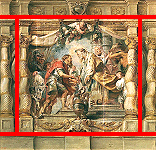 |
Rubens changed his mind about the design in "Abraham & Melchizedek". The bozzetto sketch had Solomonic columns, but a view at low level. Then in the Prado modello, he kept the Solomonic columns but gave it a fitting view looking up from below. However, in another modello (in the National Gallery) he redesigned it with Doric columns and a view at eye level. The scaled-up cartoon in the Ringling Museum is very similar to the National Gallery modello design. The tapestry in the convent also has the Doric columns and a view at eye level.
| Click on the pic on the right to compare all the designs and vanishing points. |
|
 |
|
 |
Cartoons:
After approval of the modelli, the designs would then be scaled up further to the actual size of the tapestries to be. Traditionally cartoons were drawings and watercolor on paper. In the 15th century they were called "patroon" (plural "patronen"), which gradually changed in the next century to "carton" (plural: "cartons"). Now you know where the English words "cartoon" and "cartoons" really come from.
Cartoon production was a large-scale and semi-industrialized activity in the Netherlands. Carton schilders (cartoon painters) had their own niche in the industry and produced large scale paper cartoons from modelli. In Antwerp there was a school, which turned out skilled carton-schilders.13
The height of all the eleven main Eucharist cartoons are very similar. i.e. ca. 15 feet high with various widths. Most of this scale-up work was carried out by studio assistants, but with final touch-ups an improvements by Rubens.
To aid the workshop in transferring the designs of the modelli to the cartoons, Rubens seems to have squared the cartoon panels for transfer. Remnants of the markings of a grid, subsequently erased on the surface are still visible along the edges of the Abraham & Melchizedek modello and the Triumph of Faith modello. 6, 7
| The Abraham & Melchizedek tapestry does not seem to be woven from the Ringling cartoon, but from a cartoon made from the modello in the National Gallery. There are various differences between that modello and Ringling cartoon and the tapestry incorporates all the design aspects from the modello. Look here. |
|
 |
Historians have found it difficult to explain how these oil-on-canvas "cartoons" were used by the weavers. Rubens' designs for his four tapestry commissions blew new life into a stale tapestry industry. Rubens painted the "cartoons" in oil on canvas, rather than the traditional medium of watercolor on paper, with the consequence that the design was conceived in terms of color, light and shadow, which were challenging for the weavers to reproduce in wool and silk. Tapestries were changing from decorative fabrics into paintings in wool. 14
Therefore, the Rubens oil-on-canvas cartoons were very likely in the weavers' studios for close reference on color, light and shadow (the paint was still wet), while the actual patterns on their looms were produced by specialized cartoon makers, possibly using calques. Francoise Hack explained everything perfectly, already 15 years ago. Read it here.
 |
|
One cartoon Elijah and the Angel does not follow the mirror image design. The resulting tapestry is in the same direction, suggesting that a reversed calque or a semi-transparent (normally on "butter paper") cartoon might have been used upside down by the weavers in their low warp loom. |
|
 |
Tapestries:
| • |
Background info:
The Flemish tapestry industry was a complex web of painters, cartoon makers, spinners, dyers, weavers and dealers. In Rubens' days, the corporation of tapestry-workers included upwards of a hundred masters, and around fifteen hundred workmen. The manufacture tended more and more to become concentrated in the hands of a few families, who formed positive dynasties. In 1613, to mention just one example, nine master weavers alone employed six hundred workmen, wives and children (who often helped on the job) not included.
This industrial aristocracy made great efforts to keep up the manufacturing superiority which was slipping away. In six years several masters spent 30,000 florins for cartoons alone. 12A
Most of the Flemish produced tapestries were exported. Mainly all over Europe, but particularly to Spain, Portugal and Austria. In 1604, 1400 tapestries were shipped to Spain alone. 13
|
| • |
Who produced the Triumph of the Eucharist tapestries?
They were produced by two weavers, who often worked together: Jan Raes and Jacob Geubels. Geubels did most of the smaller tapestries. Jan Raes coordinated all the work in both workshops. 15
The monograms of two other master weavers
appear on most of the tapestries
produced in the Raes workshop.
Not much is known about them. One of them was perhaps the Court tapestry weaver.
It is interesting to see that Rubens allowed the weavers to modify his chosen colors in most of the tapestries. Maybe because of the high cost of red and blue. Read more about Rubens' colors here.
|
|

Don't forget to enlarge |
|
| • |
Weaving Methods:
The tapestries are finely woven. 8 or 9 warp-threads per cm. 11p163 At this time all the looms in Oudenaarde, Antwerp and Brussels were low warp. Only Doornik (Tournay) and Brugge had high warp looms. 13p180
| Low warp weaving was 30% faster than high warp and when done by skilled weavers, even experts could not tell the difference.
In the low warp loom, the odd threads of the warp are attached to a treadle worked with the left foot, the even threads of the warp to a treadle worked with the right foot, thus making possible manipulation of the warp with the feet, leaving both hands free to pass the bobbins. |
|
 |
|
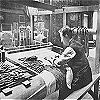 |
In the high warp loom, that has no treadle, the warps are manipulated with the left hand, while only the right hand passes the bobbins back and forth. The high warp loom then is all hand power whereas the low warp loom is hand-and-foot power. 16 Look here for a modern low warp.
|
| • |
Afzetters:
After the tapestries were woven, the afzetters took care of the finishing off. The afzetter or retoucheur could liven up de colors or shape the contours. The afzetter was not allowed to use wet paint, but he was allowed to use Indian ink. Also dry white, red and black chalk were allowed to be used to touch up faces and other body parts. The afzetter was also allowed to make small corrections with needle and thread.
The learning period was 3 years and then one was sworn in by the City council. Wives and children were allowed to help without the 3 years training. 13p189
Perhaps influenced by cartoon painters, who after Rubens aquired more authority over the completed weaves abuses arose. In 1621 an afzetter submitted a claim against Jan Raes and Jacob Geubels, two of the most powerful tapestry merchants in Brussels, because they had such touching up done by a painter. After long legal procedings the afzetter won his case in 1626, which strengthened the position of the afzetters. In 1627 a town ordinance required all Brussels' tapestry workshops, in the future, to have this correction work done by recognized afzetters. However, master weavers were also allowed to do this touching up themselves, but they still had to pay-off an afzetter for that work, which the afzetter did not even have to carry out then. 15p214 (Note: wat een afzetters)
|
| • |
Tapestries Finished and Time Table:
How long would it take to convert the cartoons into tapestries?
It took one month for one weaver to weave one square meter (just over a square yard). So, for one of the biggest tapestries e.g. "Triumph of Devine Love", which is ca. 5 x 6 meters, it would take a max. of 15 months for 2 weavers, working on one loom. But in reality, on a large loom, there could be 3 or even 4 people working at one time. Therefore, let's say it would take max. one year each to do one large tapestry. Raes and Geubels had 8 large looms each, and they had access to other looms in Brussels.
Therefore, they could easily produce 16 tapestries in a 12-15 months period in their own workshops alone.
Now, let's have a look at the actual timeline:
The tapestries were commissioned in 1625. Court documents show that Geubels (weaver workshop) was working on them in December 1626. So it seems that the weavers started as soon as one (or a) cartoon was ready. Six months later, in May 1627 Infanta Isabella's chaplain wrote in a letter that "Rubens is occupied with the paintings for the Arch Duchess and expects to finish them before the autumn".
In July 1628, all the tapestries were completey finished and were shipped to Spain. On the 14th of that month Isabella's chaplain wrote in a letter: "Her Royal Highness dispatched, two days ago, two carts which she is sending into Spain, loaded with tapestries, canvas, geographical charts and some paintings. 11p37, 9p427
So, everything fits nicely in the time table.
|
| • |
Make a tapestry. The easy way to look skinny:
The subjects depicted in the tapestries look "skinnier" than in the paintings. Not only in the large tapestries, but also in the smaller ones. Compare for yourself. Click on the pic.
|
|
 |
|
| • |
What happened after the series was completed?
There were no more Eucharist tapestries made than just this one series for the Archduchess.
However, some 40 years later, after the demise of Isabella (†1633) and Rubens (†1640), Frans van den Hecke and son Jan Frans began making numerous versions throughout the second half of the century. You will find examples of those in the table below.
How was this possible?
The Rubens' cartoons were in the Brussels palace until 1648, when King Philip IV ordered them to be sent to Spain. Read it here. Before that time Jacob Jordaens was court painter and must have had access to them. Private documents show that he had
produced paper cartoons - in watercolor- from the Rubens cartoons. 11p163
The van den Hecke tapestries do not follow the Rubens design precisely. Plain Doric columns were replaced with ornate fanciful columns, as in the Ringling Museum's tapestry, or with wide flowery borders. Click the pics.
|
|
 |
|
 |
|
| • |
 |
|
Signing
In the galloon of the tapestry in the Ringling Museum the weaver has signed his name, look here, and added a mark. It looks like two R's and a red tulip in the middle, but are two B's. What is that? Read about it here. |
|
|
Putting it all together
The table below describes all the images; from the initial small sketches (bozzetti), to the larger modelli, then the full size working "cartoons" to the woven tapestries.
| Eleven Large Tapestries |
bozzetto |
modello |
"cartoon" |
tapestry |
| Defenders of the Eucharist, The |
F |
P1, 1a |
R |
LD1,
2 |
| Four Evangelists, The |
F |
PO |
R |
LD |
| Gathering of the Manna, The |
MB |
LA |
R |
LD |
| Sacrifice of the Old Covenant |
|
B1, 1a |
|
LD |
| Meeting of Abraham and Melchizedek, The |
F |
P1, 1a, NG |
R |
LD1, 2 |
| Prophet Elijas and the Angel in the Desert |
MB |
MB |
V |
LD |
| Victory of Truth over Heresy |
F |
P1, 1a |
|
LD |
| Victory of the Euch. over Paganism (Idolatry) |
|
P1, 1a |
|
LD1, 2 |
| Triumph of Divine Love, The |
F |
P1, 1a |
R |
LD |
Tr. of the Euch. over Philosophy and Science
also called Triumph of Faith |
F |
RM |
V |
LD1, R |
Tr. of the Church over Fury, Discord and Hate
(Ignorance and Blindness) |
F |
P1, 1a |
|
LD1,
R |
| |
|
|
|
|
| Five High Altar Tapestries |
|
|
|
|
| High Altar Maquette Design |
AC |
See all 5 E |
|
All 6 LD |
| What is the dark "grille" area? |
read |
|
|
Look |
| Adoration of earthly rulers of Church |
|
SA |
info |
LD1, 2 |
| Adoration of earthly rulers of State |
view |
|
|
LD1, 2 |
| Adoration by angels |
|
S |
|
LD1, 2 |
| The Monstrance held by two Cherubs |
|
|
|
LD |
| |
|
|
|
|
| One related to High Altar |
|
|
|
|
| King David playing the Harp |
|
BA |
|
LD |
| |
|
|
|
|
| Three "Additional" Tapestries |
|
|
|
|
| Charity Enlightening the World |
|
AM |
info |
LD |
| The Succession of the Popes |
|
SD |
info |
LD |
| Historiography |
T |
U |
info |
LD |
| |
|
|
|
|
| Code: view all above letters code here. |
|
|
|
|
References
Disclaimer: read here
Willem van Osnabrugge
January, 2012 |



















